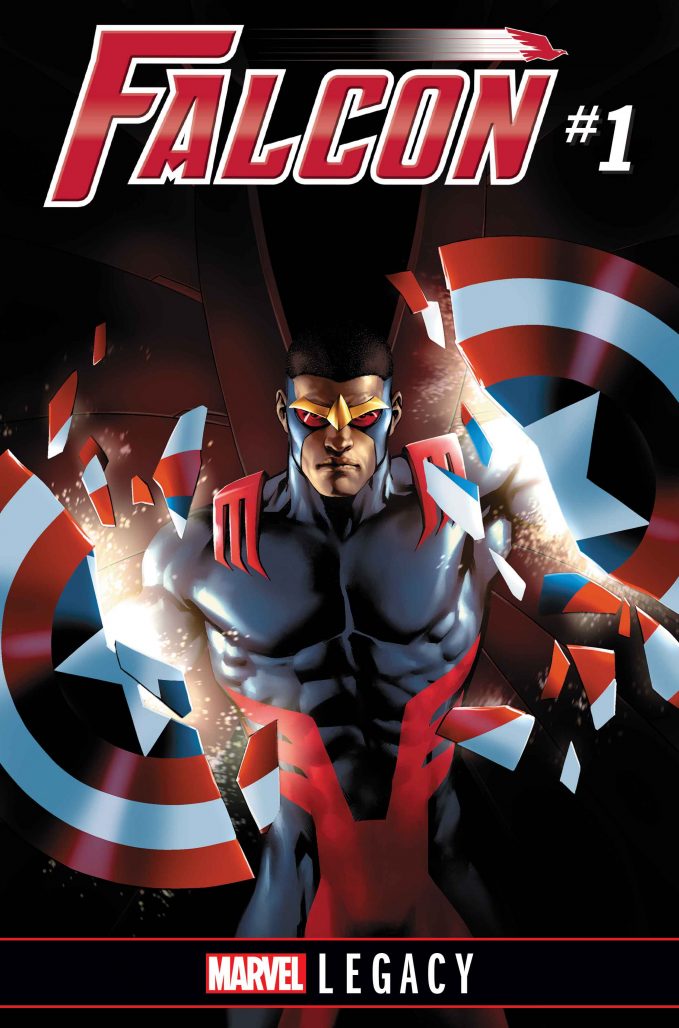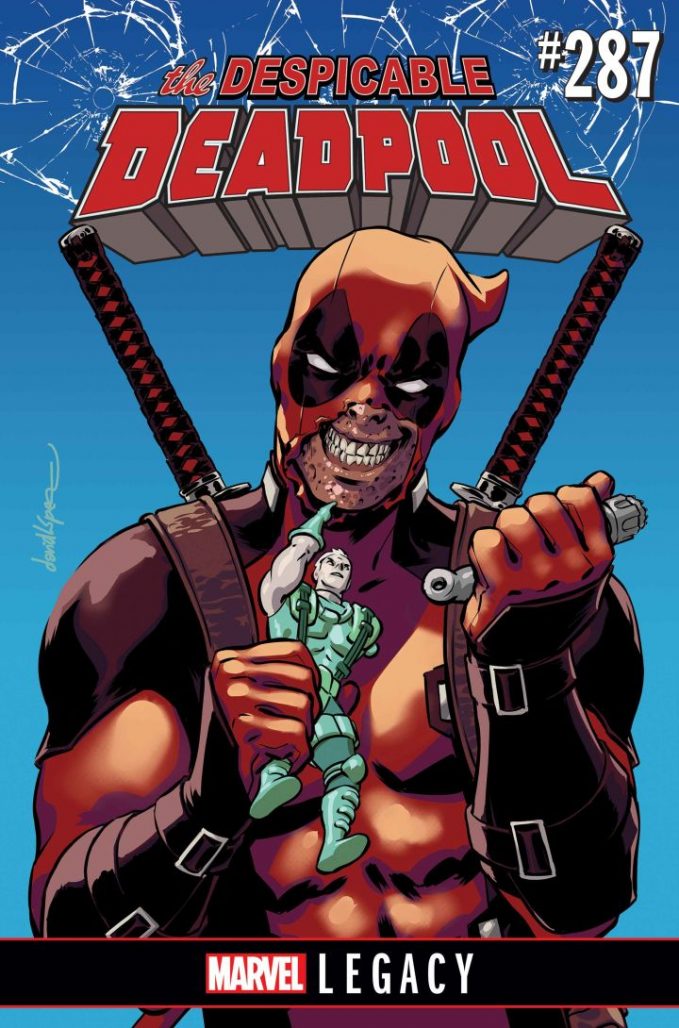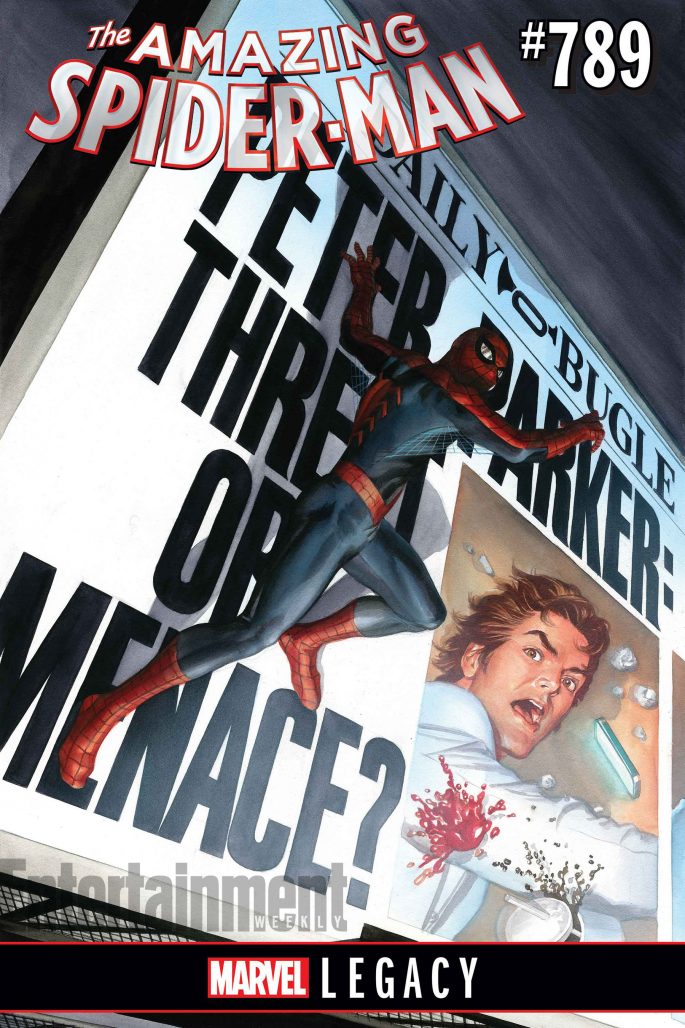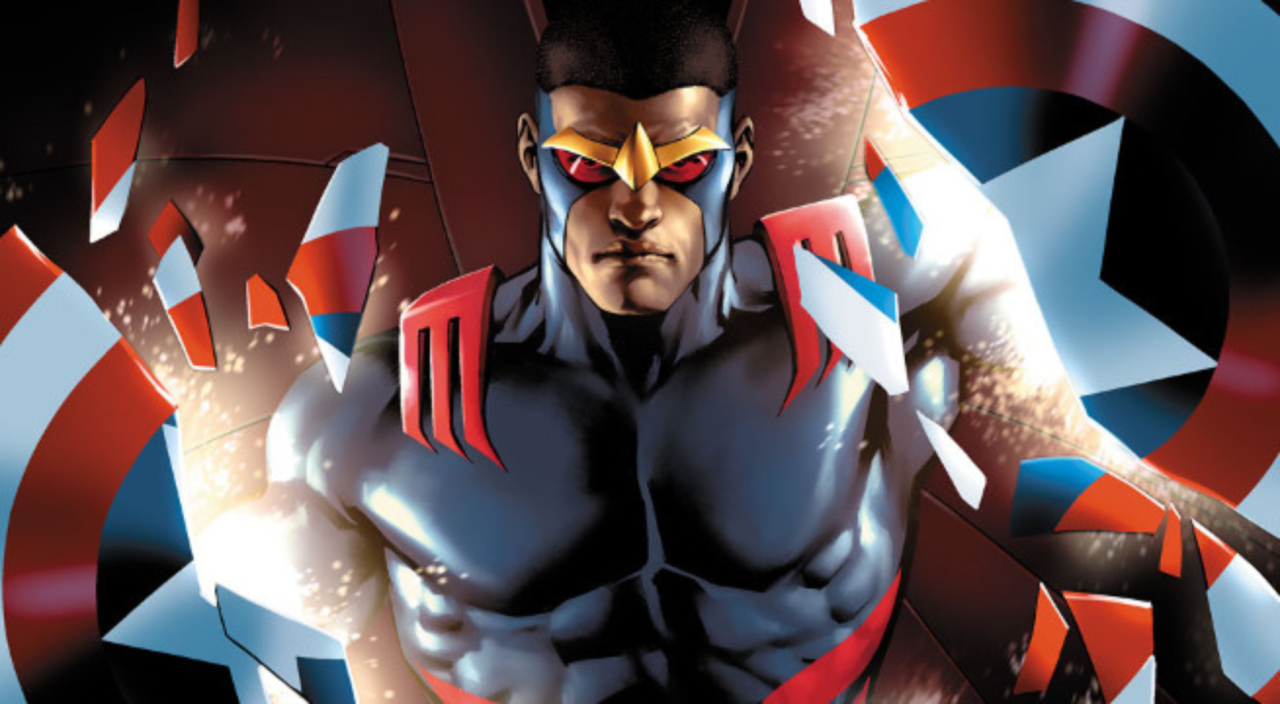The Marvel Universe is changing right before our very eyes as Sam Wilson puts down the shield of Captain America and goes back to being the Falcon. How will Wilson adjust to this new status quo after taking on the legacy of one of the biggest characters in the Marvel Universe? How will Peter Parker adjust to losing it all in the collapse of Parker Industries? Find out this week in The Marvel Rundown!

Written by Rodney Barnes and Robbie Thompson
Drawn by David Baldeon and Anthony Piper
Colored by Andres Mossa
Lettered by VC’s Cory Petit
Reviewed by AJ Frost
Alexander Jones: From the ashes of Secret Empire, Sam Wilson has shed the Captain America guise and returns to the pages of his own ongoing series as the Falcon. AJ, did this identity change feel like a regression of the character? What were your first impressions of Falcon #1?
AJ Frost: Hey there, Alex! While I can’t speak to how Sam Wilson as a character was in a previous series, but Falcon #1 a powerful and moving comic that eloquently touches the modern American sin of ignoring its curdling racism and neglect of minority populations. This was a political as I’ve seen a mainstream superhero comic be in some time. And while the themes in the writing weren’t exactly subtle, the story’s political and moral core regarding the necessity of curbing of inner-city violence added an interesting dimension to a character who has been through a lot in recent months.
Jones: This is going to be the first time in a while that we are going to disagree–however, the themes and ideas behind the issue were strong. As a whole, this comic didn’t come together for me. Seeing a big story point or emotional high for Sam Wilson’s identity change feels needed. The character doesn’t feel that he is emotionally at a breaking point but just kind of okay about cutting off ties with the Captain America moniker post-Secret Empire–this plot beat was maddening for me. I wanted more everything in this comic from a better understanding of Wilson’s current state of mind to a villain worthy of the screen time. Even with the reveal at the end of the book, this comic felt supremely distant to me. Writer Rodney Barnes did not find a way for me to adequately connect with Wilson. I’m already not satisfied with the premise of the title because the least interesting status quo shift for Wilson to endure is going back to the Falcon.
Frost: Rodney Barnes’ use of inserting a fantastical metahuman into a very real scenario is happening right now in old-school comics morality and is probably a style of approaching comics that needs to be seen more often in the Big Two’s lines. At the same time, while I can’t speak from personal experience about the perspectives Barnes projects on the characters, what is most pertinent to is the issue’s narrative successes is the sense that, through this medium, complex issues of race, street violence, and literal evil lurking behind stagnant government operations are made present for readers who may not see these entities in other media. Which is why this was a powerful comic.
Jones: As stated before I definitely have a bias on this. Lending a more analytical eye towards this comic, the amount of dialogue here is alarming especially in the scenes involving the Patriot. Barnes seems to be guilty of doing some telling instead of showing here with so much information about Shaun and Sam’s relationship doled out over speech balloons. Falcon #1 doesn’t establish a driving conflict towards the end of the book with a villain reveal. This book doesn’t see Wilson struggling to fight crime and the street-level threat seeded in the story is a minor threat for him to tackle. There’s no distinctive entry point of unique personality set for me to empathize with this story so far. I’m really worried about the disconnect towards this book. The subtext and social commentary are strong, but I don’t see those aspects of the book synthesizing with the plot to turn this into a strong narrative or a good superhero comic.
Frost: Perhaps the intention was to start off with more of a slow burn instead of instant action. Or do you think the idea is more of a cop-out on my part?
Jones: With so many books on the stands, new titles must impress right out of the gate. This book establishes the relationship between Shaun and Sam nicely but lacks the potent emotional counterpunch to guide me towards future installments.
Frost: Ah ok. I see where you are coming from. On the flip side, the humane touches, social commentary, and ethical perspective (this latter point often gets tossed aside in a lot of literature, let alone comics) give this issue a unique selling point. Agree to disagree?
Jones: Comics with the themes you mentioned above and a strong story are all the better for it because they have something to say. In the past couple of years Sam Wilson has been the star of a great many ongoing series and after reading the debut for each title, none of them seemed to stick out or find a unique angle on the character.
Frost: Only time will tell!
Jones: Aside from some of the themes and ideas was there anything about the title which stuck out to you? Did you like character relationships? Do you agree this installment may have had too much dialogue?
Frost: While there isn’t much to be said about character relationships per se, Sam and Shaun’s rapport felt genuine. They were loose with each other, which felt real. Their patter felt familial, but not in the “every sentence is a witticism” kind of way. It was solid. And honestly, on the first read through, I didn’t really think there was *that* much dialogue, but on second glance, there is a lot, but it reads pretty quickly.
Jones: Seeing Joshua Cassara as a full-time interior artist is a delight. His stylized and scratchy line work definitely gives the book some personality it wouldn’t have otherwise. The first couple pages in particular house a wonderfully dynamic action sequence making the comic feel fluid and alive despite the medium of static pictures. While this art is solid, the stiff poses and muted facial expressions in quieter scenes cause the comic to lack some of the energy gained from an opening couple of action sequences. The layouts do look a little dull in some scenes but this is solid art overall–would you agree?
Frost: I agree. There are a lot of moments which depict really vivid action (especially near the beginning and the conclusion), but some scenes in the middle are–almost literally–middle of the road. Props to Rachelle Rosenberg for another superb coloring job!
Jones: Cassara’s art definitely has some potential for growth and I will continue to look at this title and the books he is on to see if the art gets better over time. Rachelle Rosenberg’s colors are incredibly vibrant and definitely add some variety of the piece overall.
Frost: Quick question: Did you like the layouts? I thought there were some inspired placements of the panels.
Jones: There were a couple interesting ones but they didn’t manage to keep my interest all the way through. Bleeding the figures through panels looked pretty interesting but this a common technique. Some of the layouts which just had grids were pretty by-the-numbers.
Frost: Gotta love those bleeding figures!
Jones: Any last words on this book?
Frost: While we disagree, this was a great read and was really caught up in the big ideas the issue conveys. Regarding the plot of the comic, it’s only a taste of what I feel are some interesting stories to come.
Jones: I definitely want to like The Falcon and Sam Wilson but can’t get behind this story or book.
Verdict: AJ Buys, Alex Passes

Written by Gerry Duggan
Drawn by Scott Koblish
Colored by Nick Filardi
Lettered by VC’s Joe Sabino
Reviewed by AJ Frost
Look, Deadpool ain’t no saint, but you don’t expect him to go after and his (limited number of) friend, do ya? Even casual fans know that while Deadpool is an amoral rapscallion with a penchant for ludicrous amounts of quips and violence, he isn’t completely without scruples.
Yet, the main thrust of Deadpool’s Legacy storyline within issue #287 is to seek out and hunt his friend Cable, for reasons that are not entirely clear. What ensues is your typical boilerplate Deadpool yarn: excessive bloodletting, breaking the fourth wall on every other panel, not-so-subtle references to other Marvel properties, and a good smattering of infantile humor. Basically, the ultimate smorgasbord of sociopathy. But it’s all in good fun.
In following this line, writer Gerry Duggan does an admirable job of building a story that is straightforward but also has an air of mystery to it. Why exactly is Deadpool looking to kill Cable? (Or was that a reference to a clone of Cable? At this point, there are so many inter-dimensional clones versus time-traveling clones that it gets hard to keep track.) What are his motives? Why would Deadpool go so far and start hacking away? The cliffhanger ending provides some nice incentive for following the story, even if the direct lead-up does come out of nowhere to provide an odd twist in the proceedings. Further, for those that enjoy their Merc with the Mouth comics extra bloody, this issue satiates. Artist Scott Koblish makes sure that the mayhem contained within these pages squirts and oozes all over the panels, the perfect visual complement to Deadpool’s stinging verbiage.
Overall, this is a solid beginning of a new Deadpool storyline. But there isn’t anything here that would turn new readers into believers; it’s tried and true Deadpool. Duggan and Koblish work well together and their chemistry yields a familiar product. For fans of Deadpool, this will be a great issue. For those more reticent to jump in, this is a good, but inessential, starting point for your journeys with Wade Wilson and his unique brand of instability and homicidal propensities.
Verdict: Soft Buy.

Written by Dan Slott and Robbie Thompson
Drawn by David Baldeon and Anthony Piper
Colored by Andres Mossa
Lettered by VC’s Cory Petit
Reviewed by Alexander Jones
A few weeks ago I wanted to feel the full power of down-on-his-luck, sad-sack Peter Parker. For whatever reason, Peter Parker: The Spectacular Spider-Man #1 failed to elicit the primal Spider-Man impulse. However, this feeling was something Amazing Spider-Man #789 was able to achieve in full glory. The comic accidentally gave me some of the warmest, fuzziest Spider-Man sad-sack feelings from comics published decades ago featuring the character. While this book doesn’t show Spider-Man at his ultimate lowest point in history, his career is completely in the trash now and Parker feels he can’t just come out and defend his reputation without outing his identity. Forced into becoming a live-in boyfriend and wallow in guilt and feelings of depression, this is the comic which finally felt like it had something to say and the chance to really explore Peter Parker’s current foreboding mental state. The slick and subdued pencils of Stuart Immonen helps the comic integrate Parker’s emotions really nicely. The book has a corny sense of humor that falls right into place thanks to author Dan Slott’s personality which he lends to the book. I’ve never felt this way about previous stories or moments in his exploration of Parker’s character.
Surprisingly enough, Secret Empire turned out to be an incredibly important status quo shifting moment for the hero. The large-scale event storyline was the perfect opportunity for Slott to explore a surprisingly epic battle between Doctor Octopus and Spider-Man. While the nuances of such particular story aren’t referenced here, there’s something about this story which feels more organic which managed to stabilize in this storyline. The book has a couple of great scenes where Parker really takes a hard look at what he has done and assumes a portion of responsibility for the guilt he carries. This is an absurdly profound and deep moment that carries in the tradition of the original series.
While in the wake of Secret Empire, I felt Bobbi Morse and Parker’s relationship didn’t feel earned, Slott is achieving fantastic characterization for the couple here. Somehow, in some way, the writer is able to channel the same manic and unique feelings of Morse’s ongoing from Chelsea Cain and Kate Niemczyk’s landmark run on the character. Had every seen with the duo been as strong as the material written about this issue, I would have written about the book much sooner.
As mentioned before, Immonen’s work in the book is stellar. The artist gets to draw a more personal Spider-Man story and really achieves the little details. Parker has frizzy hair and a desk full of science garbage. There are notes wandering around the fridge regarding the possession of food. Character expressions and movement are both dynamically crafted. To put it simply, Amazing Spider-Man #789 is inspired work from each member of the full creative team.
Verdict: Buy. I’m as surprised as you are, definitely check this one out!
Next week: DEATH OF THE MIGHTY THOR Part 1!









If you want to read a Falcon comic that deals with real world issues and such without being hectored by some “woke” comic hack, try http://comicreliefpodcast.com/archives/1281.
Mike
How dare these creators try to be contemporary and inclusive? Don’t they know corporate owned superheroes are exclusively for old white men?
Comics were better when we were kids. What’s the matter with kids these days?
Seriously, though…it’s Big 2 comics. If you’re expecting them to be good, you’re already a lost cause.
Comments are closed.